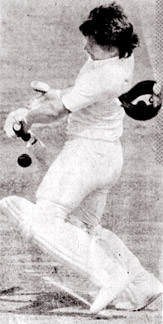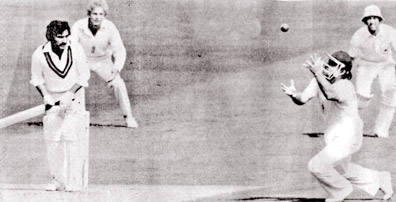|
Helmet:
A nuisance or a necessity?
By A.C. De Silva
FLASHBACK: To wear or not to wear, that is the question so far as
helmet is concerned. According to former Australian Test cricket captain
Bobby Simpson if a batsman feels he needs to wear one for whatever
reason, then indeed he should, for if he has any reason whatsoever about
his ability to handle the pacemen, his confidence may well be bolstered
by the use of helmet.
|

Quick reflexes and helmet are no guarantee against injury it
the batsman takes his eyes off the ball Ė thatís Allan Lamb
in all sorts of trouble against an Imran Khan bouncer at
Lordís in 1982. |
The use of a helmet does not in any way reflect on the courage of the
batsman who chooses to wear a helmet, nor a batsman who doesn't wear
one. What concerns most, is the matching skills of batsmen to handle the
short pitch delivery. This has been accentuated by the use of the
helmet. It is the belief that too many players now rely on the security
that the helmet gives. Too often they have neglected to learn and
practise the technique necessary to handle men of pace, whether this be
or endeavouring to hook.
Survival the key
Fast bowlers are not a new phenomenon, they have been around
virtually since cricket was first devised and it is no doubt that they
will be in the game for a long time.
For many decades batsmen survived and prospered on occasions against
the pace of people in years gone by as Gregory, Larwood, Tyson in that
era, survival meant learning how to handle the fast, rearing bumpers
that have become the mode of cricket since they first became acceptable
as part of the fast bowler's armament, after the Bodyline series of
1932. Invariably, that time,n a short delivery, which may have reared
above the waist of the batsman, was followed by an apology from the fast
bowler that 'it slipped'.
It must have been nice to have played in that era, but unfortunately,
such niceties are no longer part of a fast bowler's make-up. Indeed, why
should they be, for a bouncer, is an allowable ball and if the fast
bowler stays within the restrictions they are imposed on him by law, he
has every right to use a bouncer in whatever way he sees fit. It may be
to intimidate the batsman into surrender, or to cause him to be
dismissed when playing an attacking stroke.
In recent times, the helmet has undoubtedly created a false sense of
security in the minds of the batsmen. They firmly believe they cannot be
hurt when wearing it. Unfortunately this has not always been the case
and we have seen many injuries to batsmen who have been wearing helmets.
If the batsmen do wear a helmet and they gain some extra confidence
from it, then it is a good thing. But for it to be totally successful,
they must not neglect the art of handling the short, rising ball. They
must not discard the basic rule when facing any bowler, of matching the
ball. Batsmen who are hit normally create their own problem. This is
either by taking the eye off the ball or being inn an incorrect position
and trying to hook the ball from in front of the body. With this method,
they either miss completely or top edge it onto their face.
Hardest shot
To give a bowler an extra chance of getting you out is a cardinal sin
and it is believed most fervently a big percentage of the present
batsmen should go back to the basics in their handling of the short
delivery.
|

An unfair advantage ..... With helmet on England short-leg
fielder Mike Gatting in all set to take the catch offered by
Mansoor Akhtar (no helmet) at Leeds. |
Undoubtedly the hardest shot to play in cricket is the hook off a
genuine fast bowler. It has been made even harder in recent times, not
because bowlers have become faster, but because the bounce from the
wicket is so much more irregular than it used to be in the past.
The batsman can nook and hook successfully. If you can rely on the
bounce and the pace consistently achieved by a short delivery. If you
cannot, then you shouldn 't. Just how difficult a hook stroke is can be
judged by the number of noted hookers that have existed in cricket
through its history.
Ian Chappell - a ferocious hooker
Ian Chappell in his playing times, was the most noteworthy of the
hookers. Chappell had a love-hate relationship with the stroke. He was a
ferocious hooker.
Bob Simpson says, he on his part, went the other way. As a youngster
he was a fairly good hooker, but when he decided to become an opening
batsman he analysed what was needed to be a opening batsman and also
looked at his own strengths and weaknesses and decided that hooking
percentage-wise, just was not on. Simpson says that he had to change
from being a compulsive hooker to one who very seldom attempted the
stroke and only if it was down the leg side. He would help it on its
way, without any danger whatsoever.
Simpson added that throughout his career as an opener, he hardly
played a hook shot nor attempted to play such a shot. However, he says
within six months of his retirement from the first class scene and back
in grade cricket, his discipline had become a little lax, his natural
instincts began to take over and he was attempting to hook with dire
results. Being on who fancies survival, he quickly got his thinking back
in gear and continued the discipline which denied him the exciting but
dangerous stroke.
The former Australian skipper Simpson says that tactically he
believes a fast bowler likes nothing better than a batsman attempting to
hook with dire results. Being on who fancies survival, he quickly got
his thinking back in gear and continued the discipline which denied him
the exciting but dangerous stroke.
Watch the ball
The former Australian skipper Simpson says that tactically he
believes a fast bowler likes nothing better than a batsman attempting to
hook. He knows that everything must go right for the batsman to get away
with it. On the other hand he hates to change 30 years in, let fly a
bouncer, only to see it fly harmlessly past a batsman who allows it to
either pass his body or ducks under it. Simpson says that he knows from
many years of handling fast bowlers that this is a most heart breaking
sight.
Simpson adds that his own attitude to the helmets is that they should
only be worn in cumstances that do place the batsman in extreme danger.
Survival has to be the basic instinct of all batsmen, survival whether
it be against spinners or pacemen. The ability to watch the ball for as
long as possible is very much the number one priority in survival.
During his cricket career that no one had the capacity to hit him in
the face, provided he watched the ball closely. In his whole career, he
was hit but twice in the head.
The first was when he was a youngster, practising at the Sydney
Cricket Ground and he lent forward to play a medium pacer on a very bad
wicket and had no chance whatsoever. The ball exploded from the pitch
and took himon the nose. The second time was in his come back series
against India when he tried to hook Ghavri at the same ground.
Unfair advantage
Ghavri's rather unusual action made him a dangerous proposition to
hook, for he had the ability to bowl his shorter ball a lot quicker than
the other deliveries without any apparent change in his action.
On that occasion Simpson was hit flush, but luckily for him, in the
jaw, and no real damage was done. Simpson made a mental note then never
again to try and hook Ghavri.
On the question of helmets for the fieldsmen, Simpson says that he
has very different views. He says that he does not believe that the
short leg fieldsman should be allowed to wear a helmet, for it
undoubtedly gives him a distinct advantage. With the helmet in place, he
had much more confidence to come in closer to the batsman than he should
really be.
The confidence also allows him to field up close even to bowlers who
normally wouldn't warrant such a fieldsman.
There are very few bowlers who have the control necessary to make
fielding at short-leg a safe proposition.
As a result, any fieldsman in that position has to have good reflexes
and great courage, that is without a helmet. With a helmet, however,
anyone can go in close and do a good job.
Simpson adds that according to his thinking, the laws of cricket were
drafted never to allow fieldsmen to go too close to the batsmen.
According to his thinking, an advantage has been gained which is not
really part of cricket.
Simpson says that if he had his way, he would outlaw helmets for
fieldsmen!
|

